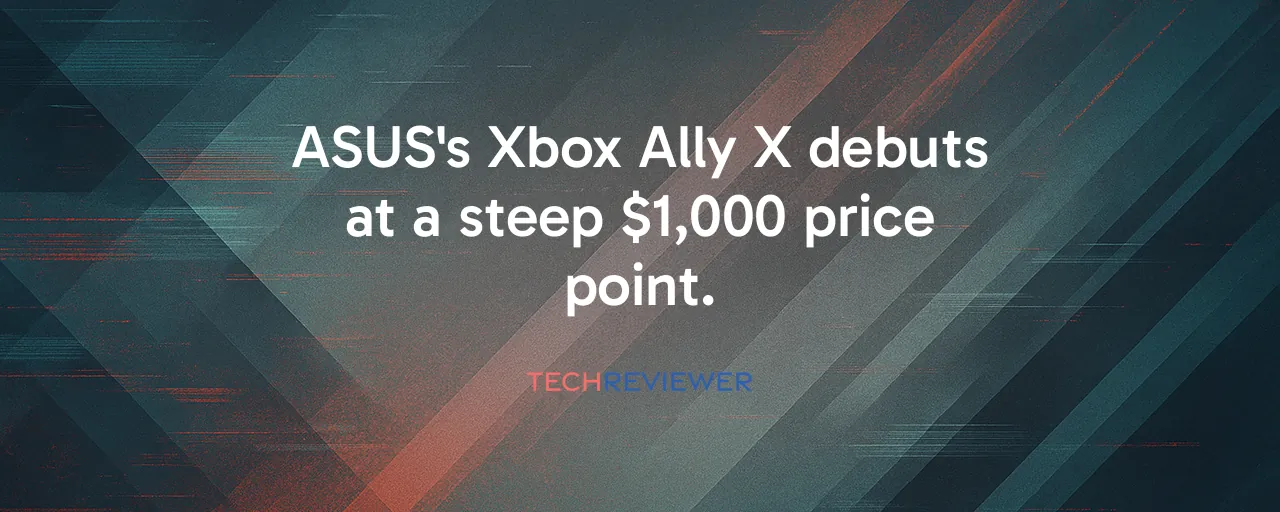A Price That Turns Heads
The ASUS ROG Xbox Ally X hit shelves in October 2025 with a jaw-dropping $1,000 price tag, sparking heated discussions among gamers. Its sibling, the Xbox Ally, comes in at a still-steep $599. Unlike traditional Xbox consoles, where Microsoft often absorbs hardware costs to grow its ecosystem, ASUS called the shots on pricing here. Xbox President Sarah Bond revealed in a Variety interview that Microsoft had no say, leaving ASUS to set the cost based on market research and the device's premium features. The result? A sold-out launch that thrilled enthusiasts but left many questioning whether portable gaming should cost this much.
This pricing strategy marks a bold shift. Handheld gaming PCs, once a niche corner of the market, are now commanding prices rivaling high-end consoles like the PlayStation 5 Pro. With the Xbox Store selling out quickly, as Bond noted, demand seems strong among dedicated players. Yet, for every excited buyer, there's another wondering if the Ally X's power justifies its cost, especially when compared to more affordable options like Valve's Steam Deck.
Power Packed in Your Pocket
Under the hood, the Xbox Ally X boasts serious firepower. It's powered by AMD's Ryzen AI Z2 Extreme processor, an 8-core, 16-thread chip with speeds up to 5.0GHz and RDNA 3.5 graphics. This delivers a 10-15% performance boost over older chips, letting you crank up settings in demanding games. Add 24GB of LPDDR5X memory, a 1TB PCIe 4.0 SSD, and a 7-inch 1080p 120Hz display with FreeSync, and you've got a device that can handle modern titles with ease. Reviewers, from IGN to PC Gamer, praise its crisp visuals and ergonomic design, calling it the most comfortable handheld yet at 715 grams.
Battery life tells a more complex story. The 80Wh battery offers about two hours of gaming in Turbo mode for AAA titles, stretching to four hours for lighter games or cloud streaming through Game Pass. ASUS's dual-fan cooling keeps things quiet at around 49.8dB, maintaining a noise level that remains unobtrusive even during extended gameplay. Connectivity shines too, with USB 4, Thunderbolt 4, and a fast microSD reader. These specs make the Ally X a technical marvel, but its Windows 11 foundation introduces some friction.
Windows Woes in a Handheld World
Running Windows 11, the Xbox Ally X offers unmatched flexibility. You can play games from Steam, Epic, Game Pass, or any PC storefront, unlike the locked-down ecosystems of consoles. Microsoft's Full Screen Experience cuts background processes, boosting performance and battery life. Still, Windows wasn't built for handhelds. Gamers on Reddit forums report wrestling with game launchers, tweaking settings, or troubleshooting compatibility issues. Some titles lack proper controller support or don't scale well on the 7-inch screen, creating headaches for players expecting a console-like experience.
This complexity frustrates Xbox fans hoping for a true portable console. The Ally X can't natively play Xbox console games unless they're PC versions or streamed via the cloud, which requires a rock-solid internet connection. Promised AI features, like Auto Super Resolution, won't arrive until 2026, meaning buyers are paying for potential that's not yet realized. For tech-savvy PC gamers, this openness is a dream, but for casual players, it's a hurdle that makes the $1,000 price harder to swallow.
Lessons From Steam Deck and Legion Go
Comparing the Xbox Ally X to Valve's Steam Deck and Lenovo's Legion Go 2 reveals stark contrasts. The Steam Deck, starting at $319 for the LCD model, prioritizes accessibility with its SteamOS, a lightweight system tailored for gaming. Valve's approach sacrifices raw power for a streamlined experience, delivering 60fps in many titles with minimal tinkering. Users on Discord praise its plug-and-play simplicity, but its hardware lags behind the Ally X's beefy specs. The Steam Deck proves you don't need a $1,000 device to enjoy portable PC gaming, especially for Steam-focused players.
Lenovo's Legion Go 2, priced at $1,350, takes a different tack, targeting enthusiasts with an 8.8-inch 144Hz display and detachable controllers. Reviews note its power but criticize its weight and short battery life, much like the Ally X in high-performance mode. Lenovo's premium pricing hasn't sparked the same backlash, perhaps because it avoids Xbox branding, setting clearer expectations as a high-end PC. These case studies show a split market: affordable, user-friendly devices versus premium powerhouses that demand technical knowledge and deep wallets.
What the ASUS-Xbox Partnership Means
The ASUS-Microsoft partnership flips the traditional console playbook. Microsoft sidesteps manufacturing costs, letting ASUS handle hardware while pushing Game Pass and its ecosystem. This low-risk move lets Xbox test the handheld waters without committing to in-house production. Bond hinted at a first-party Xbox handheld under development, suggesting the Ally X is a stepping stone. For ASUS, Xbox branding boosts mainstream appeal, building on its ROG Ally success. Yet, ceding pricing control to ASUS has left Microsoft's accessibility goals under scrutiny, as the $1,000 price clashes with its 'gaming for everyone' mantra.
Market data from Omdia shows handheld PC sales hitting 2.3 million units in 2025, with growth projected to 4.7 million by 2029. This boom reflects demand for portable gaming, but high prices risk alienating mainstream buyers. The Ally X's sellout shows enthusiasts are willing to pay, yet forums buzz with calls for price cuts. Microsoft's 2026 software updates could ease Windows woes, but for now, the Ally X is a premium gamble, powerful, flawed, and divisive.
